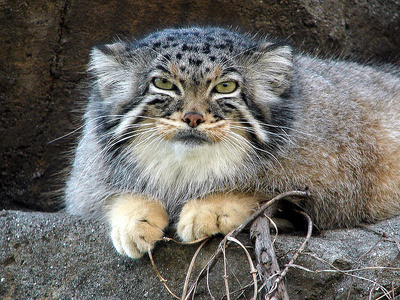A list of my favorite images of Pallas's cats.
en.wikipedia.org/wiki/Pallas%27s_cat
The Pallas's cat (Otocolobus manul), also called the Manul, is a small wild cat with a broad but fragmented distribution in the grasslands and montane steppes of Central Asia, where they inhabit elevations of up to 5,050 m (16,570 ft) in the Tibetan Plateau.
It also inhabits some parts of Afghanistan, Mongolia, Tajikistan, Kyrgyzstan, India, Kazakhstan and Pakistan, and occurs across much of western China. It is also found in the Transbaikal Krai of Russia and, less frequently, in the Altai, Tyva and Buryatia Republics. In 1997, it was reported for the first time as being present in the eastern Sayan Mountains.
It is negatively affected by habitat degradation, prey base decline and hunting, and has therefore been classified as Near Threatened by IUCN since 2002.
The Pallas's cat was named after the German naturalist Peter Simon Pallas, who first described the cat in 1776 under the binomial Felis manul.
The Pallas's cat is about the size of a domestic cat. Its body is 46 to 65 cm (18 to 26 in) long and its tail is 21 to 31 cm (8.3 to 12.2 in) long. It weighs 2.5 to 4.5 kg (5.5 to 9.9 lb).
The combination of its stocky posture and long, dense fur makes it appear stout and plush. Its fur is ochre with dark vertical bars on the torso and forelegs. The winter coat is greyer and less patterned than the summer coat.
There are clear black rings on the tail and dark spots on the forehead. The cheeks are white with narrow black stripes running from the corners of the eyes. The chin and throat are also white, merging into the greyish, silky fur of the underparts. Concentric white and black rims around the eyes accentuate their rounded shape.
The legs are proportionately shorter than those of other cats, the ears are set very low and wide apart and the claws are unusually short. The face is shortened compared with other cats, giving it a flattened look. The pupils are circular. The short jaw has fewer teeth than is typical among cats, with the first pair of upper premolars missing, but the canine teeth are large.
Pallas's cats are solitary. They spend the day in caves, rock crevices or marmot burrows and emerge in the late afternoon to begin hunting. They are not fast runners and hunt primarily by ambush or stalking, using low vegetation and rocky terrain for cover.
They feed largely on diurnally active prey species such as gerbils, pikas, voles and chukar partridges, and sometimes catch young marmots.
Added to
32 votes
Good PhotoGraphy Lists
(178 lists)list by G̲lσb̶∆L J̅∆zZ∆l!s̲↱
Published 4 years, 4 months ago  1 comment
1 comment
 1 comment
1 comment Login
Login










































